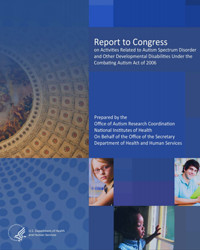Report to Congress
on Activities Related to Autism Spectrum Disorder and Other Developmental Disabilities
FY 2006 - FY 2009
This Report to Congress is required by Public Law 109-416 (PDF – 49 KB), the Combating Autism Act of 2006 (CAA). The report describes progress and expenditures made in autism spectrum disorder (ASD) research and services activities since the enactment of the CAA. Information from the following Federal departments, agencies, and offices that address ASD research or services is included:
- Department of Health and Human Services (HHS):
- Administration for Children and Families (ACF)
- Agency for Healthcare Research and Quality (AHRQ)
- Centers for Disease Control and Prevention (CDC)
- Centers for Medicare & Medicaid Services (CMS)
- Health Resources and Services Administration (HRSA)
- National Institutes of Health (NIH)
- Office on Disability (OD)
- Substance Abuse and Mental Health Services Administration (SAMHSA)
- Department of Education (ED)
In support of a coordinated Federal strategy for ASD research and services, the Combating Autism Act of 2006 reconstituted the Interagency Autism Coordinating Committee (IACC). Members include the above-listed HHS agencies (with the exception of AHRQ), the Department of Education, and public members, including people with autism, parents of people with autism, leaders of national autism organizations, a researcher, and a physician.
This report provides a summary of the IACC's efforts, in addition to those of individual Federal agencies, over the past four years. These collaborative and coordinated efforts have served well to identify promising ASD research areas, as well as to pinpoint both best-practices and gaps in ASD research and supports. Recent highlights in ASD research include the development of new diagnostic tools, identification of novel genetic and environmental risk factors, clinical trials of interventions, and measures of the efficacy and cost-effectiveness of evidence-based services for people with ASD.
In addition to descriptions of Federal ASD-related research and services-related efforts, this report also presents current ASD prevalence estimates, the present diagnostic and intervention landscape, ongoing efforts to identify gaps in and develop effective new ASD supports and services programs, and forward-looking strategies to address the continuing needs of diverse ASD communities.




